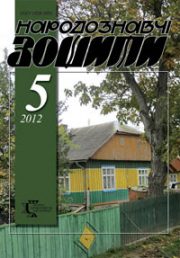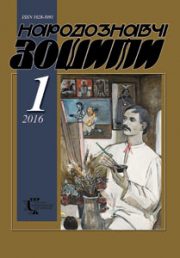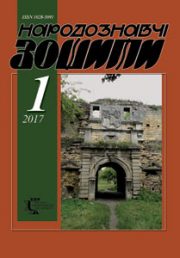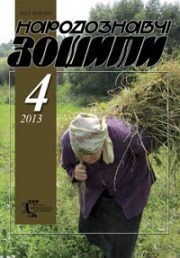The Ethnology Notebooks. 2025. № 4 (184), 979—989
UДК: 75 : [316. 647. 6 : 316. 65] (477) “1960/1990”
DOI https://doi.org/10.15407/nz2025.04.979
ARTISTIC NONCONFORMISM AND THE EMERGENCE OF CREATIVE FREEDOM IN UKRAINE (1960S—1990S)
OHONOVSKA Sofiia
ORCID ID: https://orcid.org/0000-0003-1047-9177
Postgraduate student at the Lviv National Academy of Arts,
38, V. Kubiyovycha str., 79011, Lviv, Ukraine,
Contacts: e-mail: sophia.ohonovska@lnam.edu.ua
Abstract. The article examines the phenomenon of Ukrainian artistic nonconformism and the emergence of creative freedom in Ukraine during the 1960s—1990s. Throughout the Soviet period, the Ukrainian art scene operated under cyclical political pressure, with phases of partial liberalization alternating with periods of intensified ideological control. These factors shaped the dynamics of alternative artistic practices, which not only opposed the official ideology but also laid the groundwork for the establishment of creative freedom at the end of the twentieth century. Local centers of unofficial art and the underground played a particularly important role in these processes, as their initiatives ensured the continuity of the modernist tradition and supported artistic experimentation.
Problem Statement: this study aims to supplement and refine existing scholarship on Ukrainian nonconformism by focusing on those aspects of chronology, sociocultural dynamics, and regional specificity that have remained less systematically explored in previous research.
The purpose of the study is to determine how Ukrainian artistic nonconformism evolved under the influence of historical and sociocultural transformations, what factors contributed to its development, and how these processes affected the formation of creative freedom in Ukraine.
The research applies a set of methods, including historical-cultural, comparative, and contextual analysis, which make it possible to identify both general patterns and local particularities in the development of the nonconformist movement.
The results of the study consist in identifying and characterizing the key stages, regional centers, and mechanisms of self-organization and institutionalization of underground initiatives within the art scene. In conclusion, the article argues that Ukrainian artistic nonconformism should be seen not only as a form of resistance to ideological pressure but also as an active component of the process of establishing creative freedom in Ukraine during the late 1980s and early 1990s, as well as preserving the continuity of artistic traditions.
Keywords: artistic nonconformism, nonconformism, underground, freedom of creativity, transformation of Lviv’s artistic environment, artistic environment of Lviv, visual arts.
Received 16.07.2025
REFERENCES
- Holubets, O. (2012). Art XX Century: Ukrainian Way. Lviv: Kolir PRO [in Ukrainian].
- Vysheslavskyi, H. (2006). Nonconformism: Underground and «Unofficial Art». Artistic Culture. Topical Issues, 3, 171—198. Retrieved from: http://nbuv.gov.ua/UJRN/khud_kult_2006_3_16 (Last accessed: 03.07.2025) [in Ukrainian].
- Vysheslavskyi, H. (2022). The Art of Oleksandr Stakhov-Shuldizhenko: A Legacy Infused with Many Cultures. The Modern Art Research Institute of the NAA of Ukraine. Nizhyn: PP Lysenko M.M. DOI: 10.31500/978-617-640-573-3 [in Ukrainian].
- Vysheslavskyi, H., & Sydor-Hibelinda, O. (2010). Terminology of Contemporary Art: Definitions, Neologisms, Jargon of Contemporary Visual Art in Ukraine: A Dictionary. Kyiv: Terra Incognita [in Ukrainian].
- Vysheslavskyi, H. (2021). Neo-Avant-Garde Tendencies of Nonconformist Art in the 1980s (Odesa APTART). Modern Art, 17, 9—22. DOI: 10.31500/2309-8813.17.2021.248422 [in Ukrainian].
- Кushch, S. (2011). «Portraits» of Resistance. Retrieved from: https://web.archive.org/web/20200930062545/https://day.kyiv.ua/uk/article/naprikinci-dnya/portreti-sprotivu (Last accessed: 07.07.2025) [in Ukrainian].
- Petrova, O. (2000). «Noah’s Ark»: Painting of the Second Half of the 20th Century. Trends: Catalog (Pp. 117—121). Kyiv: National Art Museum of Ukraine [in Ukrainian].
- Smyrna, L. (2006). Ukrainian Artistic Nonconformism: Historical and Worldview Dimension. Essays on the History of Fine Arts of Ukraine of the 20th Century (Vol. 2, pp. 5—76). Kyiv: The Modern Art Research Institute of the NAA [in Ukrainian].
- Petrova, O. (2000). The Utopia of Artistic Freedom in the 1960s in Projection onto the Fine Art Realities of the Early 20th Century. Scientific Notes, 18, 171—175. Retrieved from: https://ekmair.ukma.edu.ua/server/api/core/bitstreams/c8c646b7-9be1-432e-ae08-7387ef6f2b71/content (Last accessed: 10.07.2025) [in Ukrainian].
- Smyrna, L. (2016). Legitimization of Nonconformism: The Process Has Begun. Retrieved from: http://artukraine.com.ua/a/ukrainskiy-misteckiy-nonkonformizm-chastina-1/#.V12CDo9OLIU (Last accessed: 10.07.2025) [in Ukrainian].
- Avramenko, O. (2006). Changes in the Paradigm of Fine Art Functioning in Ukraine from the 1950s to 2005. Essays on the History of Fine Arts of Ukraine of the 20th Century (Vol. 2, pp. 193—239). Kyiv: The Modern Art Research Institute of the NAA [in Ukrainian].
- Vysheslavskyi, A. (2020). Contemporary Art in Ukraine: From Underground to Mainstream. Kyiv: The Modern Art Research Institute of the NAA of Ukraine [in Ukrainian].
- Holubets, O. (2001). Between Freedom and Totalitarianism: The Artistic Environment of Lviv in the Second Half of the 20th Century. Lviv: Akadem. Ekspres [in Ukrainian].
- Skliarenko, H. (2006). Ukrainian Art of the Second Half of the 1980s—2000s: Events, Phenomena, Directions. Essays on the History of Fine Arts of Ukraine of the 20th Century (Vol. 2, pp. 353—392). Kyiv: The Modern Art Research Institute of the NAA [in Ukrainian].
- Sydorenko, V. (2008). Visual Art from Avant-Garde Shifts to New Directions: The Development of Visual Art in Ukraine in the 20th—21st Centuries. Kyiv: VKh [in Ukrainian].
- Skliarenko, H. (2009). «New Wave» and Ukrainian Art of the Late 20th Century. Modern Art, 6, 188—196. Retrieved from: http://nbuv.gov.ua/UJRN/S_myst_2009_6_18 (Last accessed: 10.07.2025) [in Ukrainian].
- Luhovska, A., & Lagutenko, O. (2023). The Establishment of Art Institutions in Kyiv (1990s—2020s). Ukrainian Academy of Arts, 33, 252—259. DOI 10.32782/2411-3034-2023-33-29 [in Ukrainian].
- Dymshyts, E. (2006). Ukrainian Painting of the Late 1950s — Early 1990s. Essays on the History of Fine Arts of Ukraine of the 20th Century (Vol. 2, pp. 150—192). Kyiv: The Modern Art Research Institute of the NAA [in Ukrainian].
- .Smyrna, L. (2017). A Century of Nonconformism in Ukrainian Visual Art. Kyiv: Feniks [in Ukrainian].
- Тkachuk, I.L. (2021). Painting of the Ukrainian Art Groups «Paris Commune» and «Picturesque Reserve» from the Late 1980s to the Mid-1990s: Integrative Models of Perception. (Doctoral dissertation). Lviv National Academy of Arts [in Ukrainian].
- Vysheslavskyi, H. (2014). «New Wave» in Ukrainian Visual Art of the Late 1980s — Early 1990s (Sociocultural Aspect). (Dr. diss. abstr.) The Modern Art Research Institute of the NAA of Ukraine. Kyiv [in Ukrainian].
- Sydor-Hibelinda, O. (1995). Necrology for «Commune». Terra incognita, 3/4, 50—52. Retrieved from: https://uartlib.org/downloads/TerraIncognita34_uartlib.org.pdf (Last accessed: 11.07.2025) [in Ukrainian].
- Lozhkina, A. (2019). Permanent Revolution: Art of Uk ra ine, 20th — Early 21st Century. Kyiv: ArtHuss [in Ukrainian].
- Мaleoniuk, K. (2019). Savages and Decadents: Avant-Garde Exhibitions in Pre-Revolutionary Ukraine. Retrie ved from: https://amnesia.in.ua/avant-garde-ukraine?fbclid=IwY2xjawH25_dleHRuA2FlbQIxMAABHeTwG1kJX9LGxAGdlVcjz2LpN6plaMgrH2I4YFnzaQ5vR8lXdOo_e5QJ1Q_aem_GN05MbNEx-ulLCW3LSLTjQ (Last accessed: 10.07.2025) [in Ukrainian].
- Кotova, O. (2013). Features of the Odesa School of Painting from the Second Half of the 20th Century to the Present. MIST: Art, History, Modernity, Theory, 9, 137—145. Retrieved from: http://nbuv.gov.ua/UJRN/Mist_2013_9_14 (Last accessed: 11.05.2025) [in Ukrainian].
- Meeting with Heorhii Kosovan: Deflation and Contemporary Art in Lviv in the 80s and 90s. Retrieved from: https://yagallery.com/digest/defloraciya-yak-rozvivalos-suchasne-mistectvo-v-ukrayini-80-90-h-rokiv-zustrich-z-kuratorom-pershih-vistavok-georgiyem-kosovanom (Last accessed: 10.07.2025) [in Ukrainian].
- Vysheslavskyi, H. (2006). Contemporary Visual Art of Uk raine During the Postmodern Period. Essays on the History of Fine Arts of Ukraine of the 20th Century (Vol. 2, pp. 424—481). Kyiv: The Modern Art Research Institute of the NAA [in Ukrainian].
- Оleksii, A. (2021). «Live Oko» — The First Informal Association in Uzhhorod. Informal Art of Uzhhorod in the 1990s (Pp. 10—14). Retrieved from: https://artarsenal.in.ua/wp-content/uploads/2021/03/Neformalne_mystetstvo_Uzhhoroda_book_web.pdf (Last accessed: 01.07.2025) [in Ukrainian].
- Panchyshyn, I. (1993). «Impreza-93»: Third International Biennial of Easel Arts (Exhibition Catalogue). Ivano-Frankivsk: Vidrodzhennia. Retrieved from: https://postimpreza.org/library/tretie-mizhnarodne-biienale-stankovykh-mystetstv-impreza-93 (Last accessed: 08.05.2025) [in Ukrainian].
- Мelnyk, V. (1996). Ivano-Frankivsk: 1989—1995. Terra Incognita, 5, 32—35. Retrieved from: https://uartlib.org/downloads/TerraIncognita5_uartlib.org.pdf (Last accessed: 08.05.2025) [in Ukrainian].







